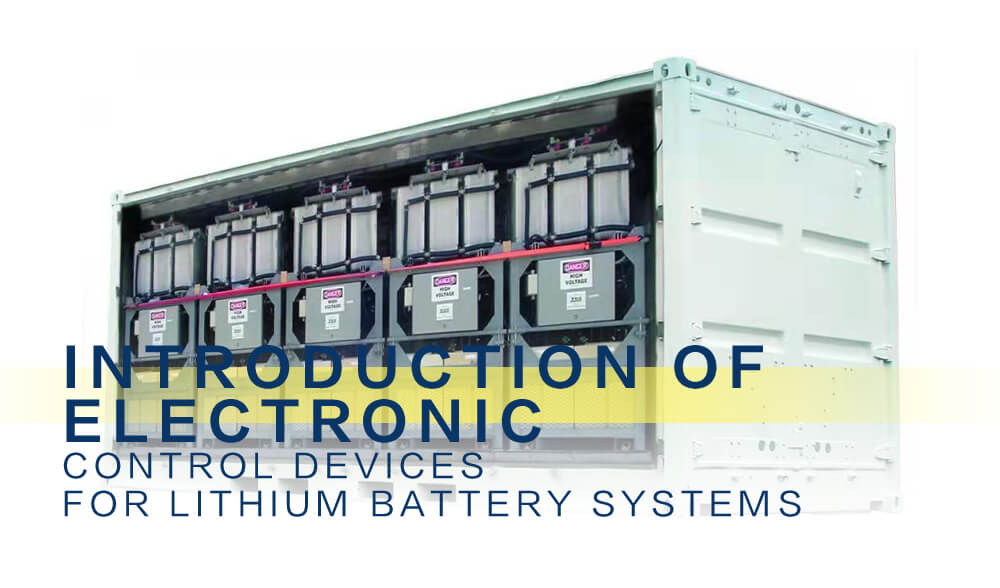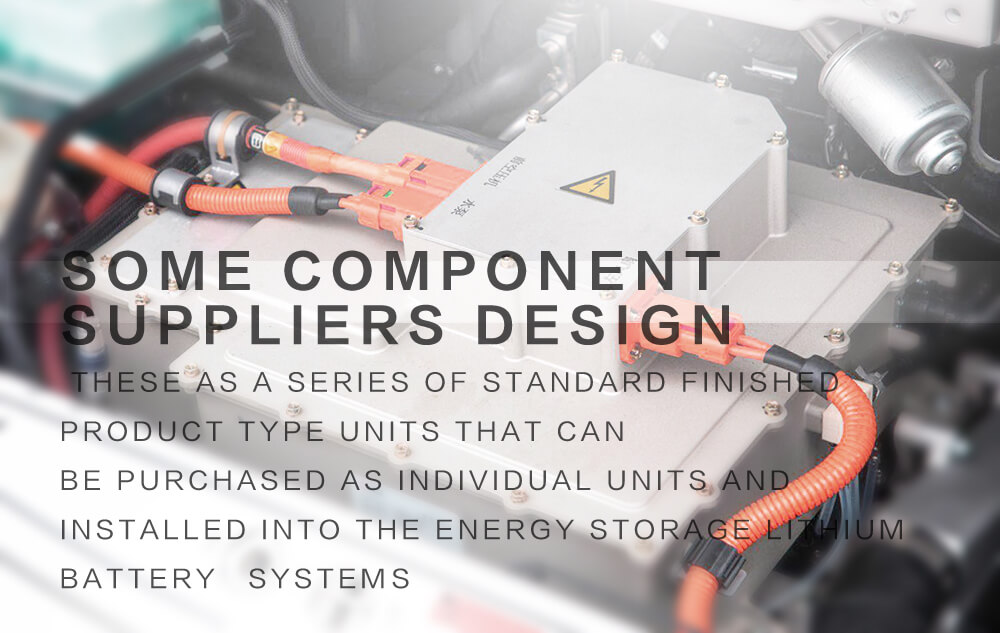Home » battery management system » Introduction of electronic control devices for lithium battery systems
Introduction of electronic control devices for lithium battery systems
The same basic electronic hardware will be used in both low and high voltage lithium battery systems(such as UPS lithium battery、lithium ion car battery and so on).
They include: main contactor, prefilled contactor, high-voltage Interlock Loop (HVIL), Manual Service Disconnect (MSD), fuse, bus, cell link board, low Voltage wiring harness and High Voltage wiring harness. These components are collectively known as the high-voltage Front End (HVFE).
Low and high voltage lithium battery systems
The choice of high voltage front-end electronic components is based on the voltage of the lithium battery systems. High voltage devices should be considered for systems with voltages over 60V, as exposure to high voltages above 60V can result in severe injury or even death.
Therefore, high voltage (HV) systems require additional safety precautions, which must be considered in the design to ensure the safety of the operator during system operation or maintenance.
If the voltage of the lithium battery systems is below 60 V, people can get numb when they touch it, but it is usually not life-threatening. Therefore, a theoretically safe battery system would prefer a low voltage design.
Although low voltage lithium battery systems do not require as complex hardware and control components as high voltage systems to ensure safety, appropriate safety systems are still required.
The voltage peak for most automotive applications is around 400 V, while mWH-class battery systems in power stations and some industrial applications can exceed 1000 V. The type of high voltage device selected must be suitable for the highest voltage of the system.
As mentioned in the Battery Management System (BMS) article, another important thing in battery design is to ensure electromagnetic compatibility (EMC) and electromagnetic interference resistance (EMI) of the system.
This includes the proper use of shielded wiring, as well as evaluating the design and placement of PCBS and control panels in the system. In addition, the packaging material also helps to improve the electromagnetic compatibility and electromagnetic interference resistance of the lithium battery systems.
Contactor/relay
The purpose of an electromechanical switch or relay is to connect the circuit to allow current to flow, or to disconnect the circuit to stop current from flowing.
Switches are another very important design and safety element in lithium battery systems because they can stop or disconnect the current and voltage output from the battery. A switch is considered an electromechanical device, which is a mechanical operation.
Switches are usually sealed in airtight containers filled with non-conducting gases, which not only avoid sparks when the circuit is turned on or damaged, but also can be used in corrosive environments, such as in the harsh environment of automobile exhaust to avoid contamination or corrosion.
There are now many large companies that provide finished switches for electrical systems. Therefore, people prefer to cooperate with the manufacturer of these components to choose the appropriate switch for their lithium battery systems, rather than designing the switch themselves.
The switch is usually connected using a pre-charged contactor or a pre-charged resistor. This is an auxiliary switch in parallel with the main switch. The function of this switch is to avoid a sudden high current situation when the main switch is closed.
The secondary switch needs to be closed first to begin allowing small currents to flow into the system, so that when the main switch is fully closed to form a loop, other circuits can be prevented from being damaged or the main switch can be dangerously fused in the closed position.
Figure below this paragraph shows the three main switches in parallel with the precharge switches. At the top of the figure, both the main switch and the pre-charge switch are disconnected, so there is no current in the lithium battery systems at this time, that is, the position is open.
In the middle circuit diagram, the precharge switch is closed, so a small amount of current is allowed to flow at this time, while the main switch remains off for a predetermined amount of time. In the final circuit diagram, the main switch is also closed, the lithium battery systems allow all current to flow through, and the system switch is in the on position.
In most lithium battery systems, there is only one switch and a pre-charge switch. However, some large systems consist of a series of parallel circuits, each in series having its own control switch so that they can operate independently under their own control.
High voltage interlocking circuit
Many high-voltage energy storage lithium battery systems include a safety component called the high-voltage Interlock Loop (HVIL), which creates a closed circuit when the battery pack is packaged. If part of the battery pack is opened, the circuit switch is turned off and the current stops flowing.
It is important to note that in the battery pack design, not only the HVIL elements can be installed in the battery pack, but other components and control units need to be installed in the lithium battery systems, but the battery pack can only be opened if the HVIL is damaged.
The reason for this is to ensure the safety of personnel who turn on the battery system during maintenance or repair of the battery pack.
One way to do this is to connect the electric car’s cable to the interlock circuit and then report this status to the battery pack’s controller. In this type of lithium battery systems, when the BMS controller recognizes that one of the interlocking circuits is turned on, the battery controller will give the switches a message to force them to disconnect, so the high voltage bus is discharged and the battery is safely turned on.
Another way to achieve this is to connect to the high voltage power supply via MSD (Manual Service Disconnect) device with built-in high voltage fuse and high voltage interlock. In the external short circuit when the fuse cut off the high voltage circuit;
When the high voltage needs to be manually disconnected, the high voltage interlock is disconnected first and then the high voltage circuit is disconnected. MSD physically disconnects the battery pack from external high voltage, ensuring the safety of maintenance personnel.
Fuse
As mentioned earlier, most high-voltage energy storage lithium battery systems in vehicles have MSDS, which are designed as part of the HVIL. The HV power supply wires are connected through the MSDS.
The MSDS are usually installed in the middle of the battery pack, for example, in a 100-string battery pack, the MSDS are usually installed in the middle of the 50-string battery pack.
To ensure that the disconnection functions to reduce the total voltage, the total voltage is cut into several lower voltage segments to reduce possible safety risks.
Depending on the battery type, other fuses can sometimes be taken into account when designing an MSD. Low-voltage batteries generally do not need to consider MSD, but one or more fuses may be required depending on the lithium battery systems design.
And when a fuse blows, some OEM(Original Equipment Manufacturers) have integrated small fuses directly into the control panel. This provides additional security in the event of a single or parallel cell failure or voltage surge.
Large energy storage systems may not have MSD fuses, but other types of fuses are typically built into the battery to ensure safety. Fuses are also often integrated into Battery Disconnect units (BDU) for large lithium battery systems.
Battery disconnect unit
In most hybrids, the electronics and subsystems are located somewhere in the battery pack. In fact, some component vendors and OEMs assemble them in a separate physical unit called a BDU (Battery disconnect Unit).
Although the BMS is usually installed separately from the BDU, the BDU can provide communication services for electronic detectors, car controllers, and the outside of the car.
Some component suppliers design these as a series of standard finished product type units that can be purchased as individual units and installed into the energy storage lithium battery systems. The main switches, pre-charging switches, fuses, HVIL, and other electronic hardware can all be a single unit.
Companies such as Delphi and Tyco Electronics can provide off-the-shelf high voltage units based on customer electrical experience and application requirements, which greatly saves engineering teams time and improves engineering efficiency.
Connector
Another important component to consider when designing control and lithium battery systems is the connector. Because the lithium ion battery industry is just getting started and is less standardized, there are likely to be many solutions available, each with different costs and benefits, and not all of them compatible.
In addition, connectors used in many portable electronic devices have not been proven to meet reliability requirements in the automotive sector.
Connectors must meet battery packaging requirements, withstand harsh environments, EMI shielding, and meet current, voltage, and communication requirements without significantly increasing system costs.
The connectors that connect mod-module and cell to cell are very important. Some connector manufacturers have developed connection designs that make installation and maintenance easier.
Amphenol’s “Radsok” connector, for example, is easy to install and disassemble. Its only drawback is that it costs more than conventional connectors.
Connectors and wiring are secured by a built-in latch design, which is not only necessary for power battery packs in transportation applications, but is recommended for consideration in all lithium battery systems.
By integrating interlocking connectors, ensure that these connections do not detach or detach over time. In addition, yellow high voltage wires, as specified by SAE Standard J1673, are used to distinguish them from the electric wires in the car.


























